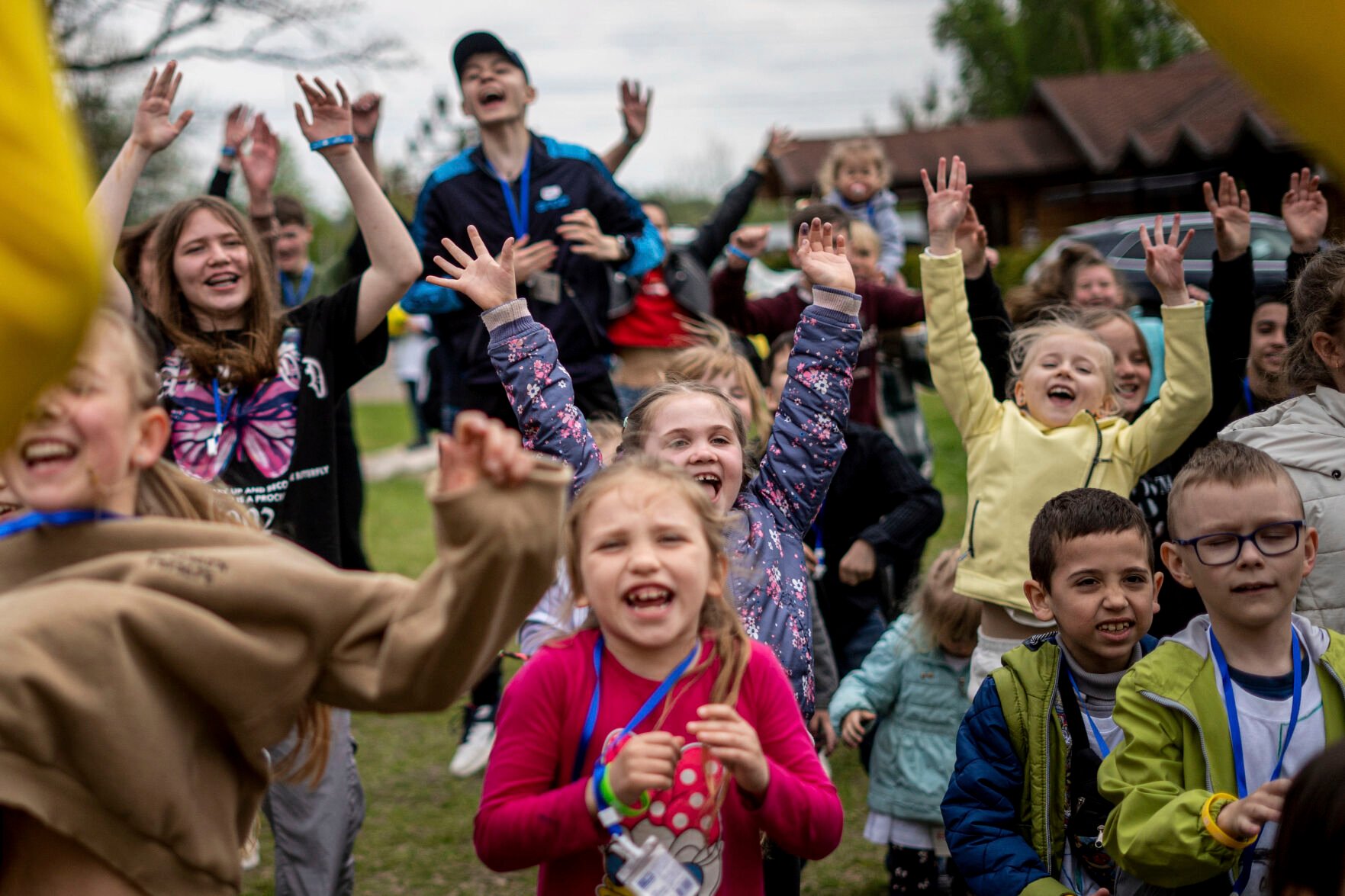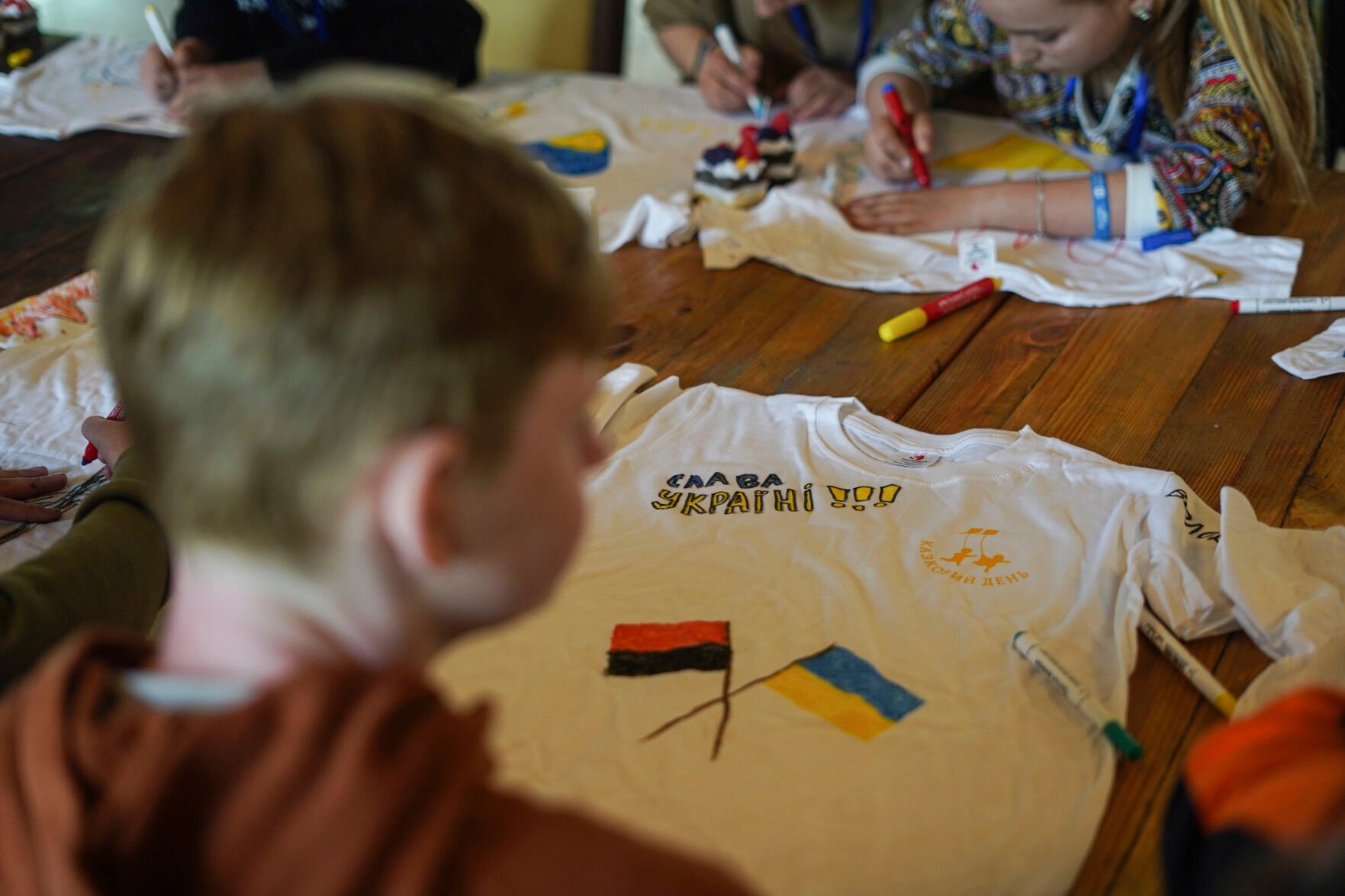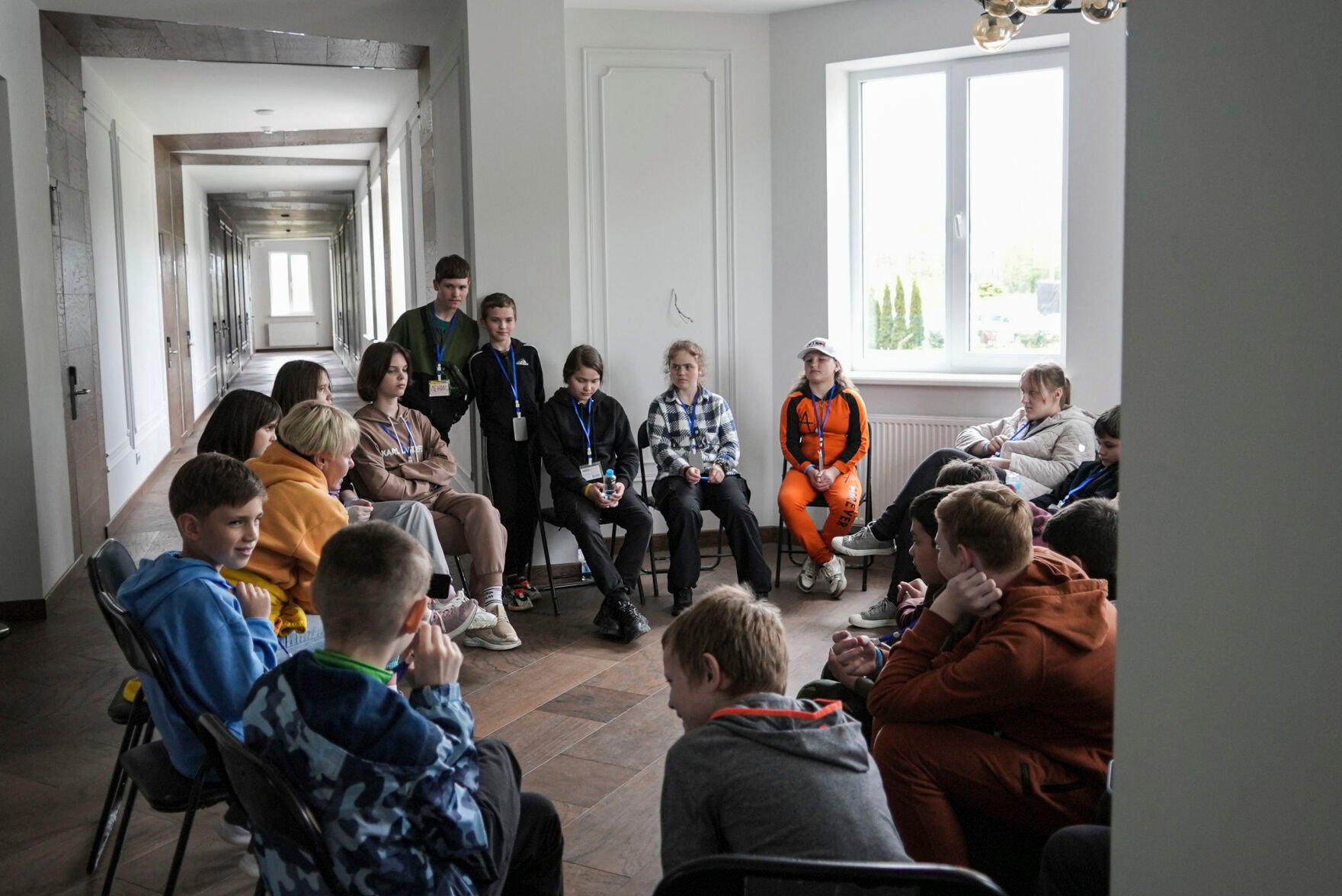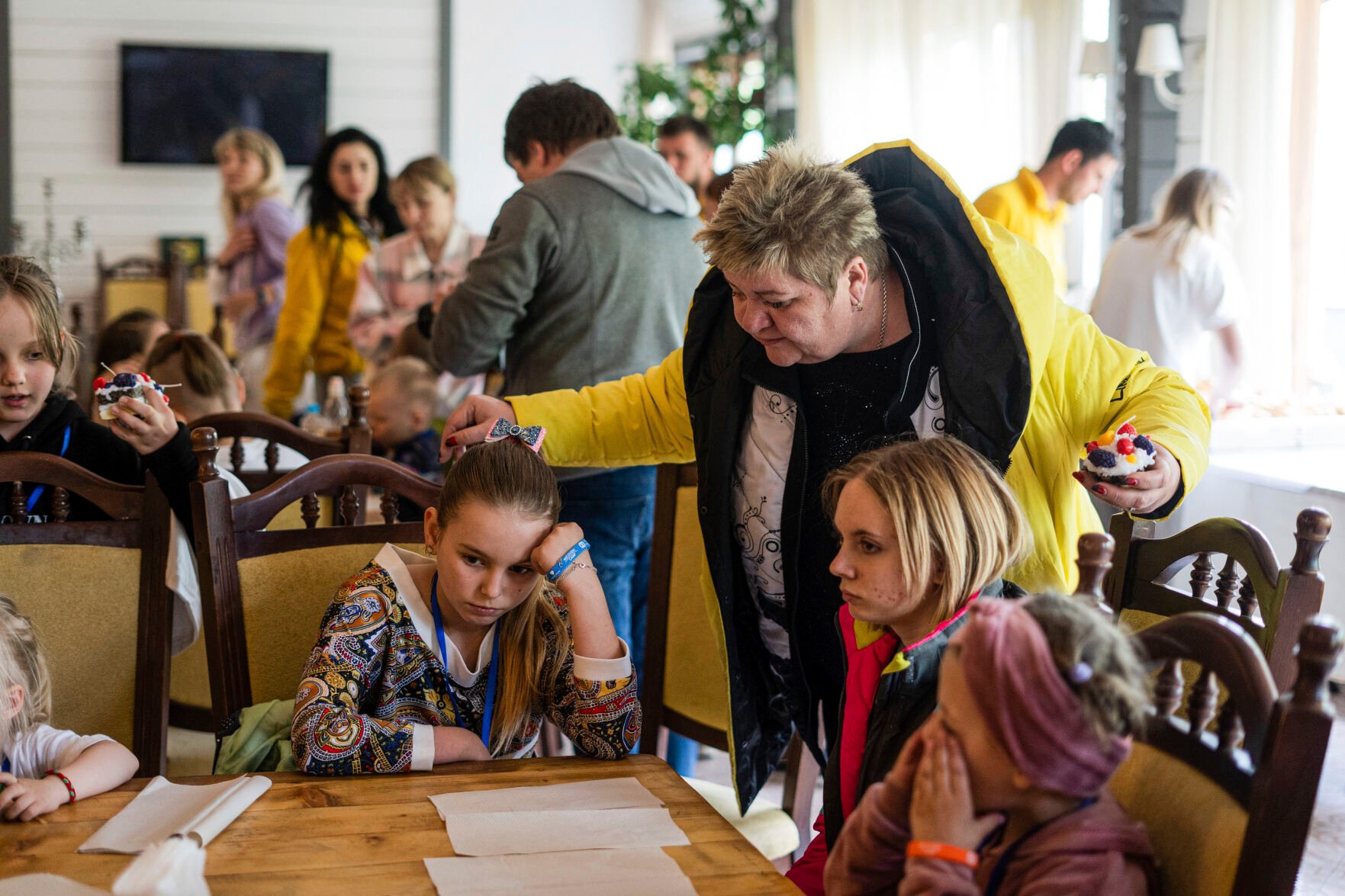LVIV, Ukraine — The two children squinted to see through the thick smoke that hung in the air after a deafening blast shook their small home in Ukraine’s eastern Donetsk region.
The pair, ages 9 and 10, called out for their father. Only eerie silence followed.

Hanna Arhirova, Associated Press
Children dance at the recovery camp for children and their mothers affected by the war near Lviv, Ukraine, on May 3. A generation of Ukrainian children have seen their lives upended by Russia's invasion of their country.
Then Olha Hinkina and her brother, Andrii, rushed to the bomb shelter, as they had been taught. When the booms stopped and the smoke cleared, they found their father on the porch — motionless and covered in blood after being struck by a Russian projectile.
“Father was killed at seven in the morning,” said Andrii, who now lives in the safer western city of Lviv, near the border with Poland.
The two siblings join a generation of Ukrainian children whose lives have been upended by the war. Russia’s full-scale invasion has subjected them to constant bombardment, uprooted millions from their homes and turned many into orphans.
Hundreds of kids have been killed. For the survivors, the wide-ranging trauma is certain to leave psychological scars that will follow them into adolescence and adulthood.
“Even if children fled to a safer area, it doesn’t mean they forgot everything that happened to them,” said psychologist Oleksandra Volokhova, who works with children who escaped the violence.
At least 483 children have lost their lives and nearly 1,000 have been wounded, according to figures from Ukraine’s general prosecutor’s office.

Hanna Arhirova, Associated Press
A boy decorates a T-shirt with words "Glory to Ukraine" at a recovery camp for children and their mothers affected by the war May 3 near Lviv, Ukraine.
Meanwhile, UNICEF says an estimated 1.5 million Ukrainian children are at risk of depression, anxiety, post-traumatic stress disorder and other mental health issues, with potentially lasting effects.
Nearly 1,500 Ukrainian children have been orphaned, the National Social Service of Ukraine said.
The largest number of child casualties comes from Donetsk, the epicenter of many battles, where 462 children have been killed or wounded, according to Ukrainian officials.
That figure does not include casualties from the Russian occupied city of Mariupol, which is also part of Donetsk province, where Ukrainian officials have found it difficult to track the dead and wounded.
Before the war tore them apart, the Hinkin family was like any other living in the village of Torske, which today is just 22 miles from the front.
With the death of their father in October, the children were orphaned. Their mother died years before the war.

Vasilisa Stepanenko, Associated Press
Nina Poliakova comforts her son Andrii Hinkin at the recovery camp for children and their mothers affected by the war near Lviv, Ukraine, on May 3.
Six months later, the siblings appear to be moving past the worst of their ordeal.
Police and volunteers evacuated them to a safer area in western Zakarpattia region, where they were cared for by government social services and a Ukrainian charity organization called SOS Children’s Villages, which provided housing and counseling.
Their story became known in and around Torske after police released a widely seen video that showed their father’s body being removed from the family home.
“We knew the village. We knew where they lived. We knew these people,” said Nina Poliakova, 52, from the nearby town of Lyman.
Although she fled last year with her family to Lviv, Poliakova continued to follow news from her native area. Then tragedy struck her life as well when her 16-year-old foster son died suddenly from a heart condition.
She also has a 16-year-old foster daughter she took in with her husband in 2016 from the occupied town of Horlivka, where hostilities with Russian-backed separatists began, years before the 2022 invasion.
Mired in grief, Poliakova received a call one day from a local center supporting children. The caller asked if she would be willing to meet the Hinkin siblings.
At their first meeting, they talked mostly about the Hinkin family home and the domestic animals they had. One of Andrii’s favorite activities was to feed the pigs.
Poliakova decided to welcome the two children into her extended family.

Vasilisa Stepanenko, Associated Press
Children attend a group therapy class at a recovery camp for children and their mothers affected by the war near Lviv, Ukraine.
“We had that tragedy in our family, and then fate just brought us together,” Poliakova said. “Now many children have been left alone, without parents. Children need care, love. They seek to be embraced and comforted.”
Many foundations have emerged to help children overcome the trauma of war, including a group called Voices of Children, which has processed around 700 requests from parents looking for help with children suffering from chronic stress, panic attacks and symptoms of PTSD.
The pleas have changed as the war has progressed, according to a report issued by the charity. During this past winter, parents sought help after noticing behavioral changes in their children including apathy, aggression and anxiety, sensitivity to loud noises and anti-social habits.
“A child’s psyche remains more malleable than that of adults, and with timely and quality support, we understand that a child can more easily overcome any traumatic events,” said Olena Rozvadovska, the head of Voices of Children.

Hanna Arhirova
Nina Poliakova speaks to her foster daughter Olha Hinkina at the recovery camp for children and their mothers affected by the war near Lviv, Ukraine, on May 3.
Recovering from months living so close to combat lines was difficult for the siblings, Poliakova said.
“They were very scared,” she said. Olha would cry and hug her every time she heard the air-raid sirens. Andrii was relatively calm during the day but would start screaming in the middle of the night.
When Andrii Hinkin remembers his hometown, he doesn’t recall the bombs, the smoke or the thunderous explosions. He remembers it as a beautiful village.
Asked what are his biggest dreams, he responds timidly. “I want to grow up.”
-
Here are 5 ways the war in Ukraine has changed the world
Ukrainian Presidential Press Office via AP, File
Three months before the invasion, then-British Prime Minister Boris Johnson scoffed at suggestions that the British army needed more heavy weapons. “The old concepts of fighting big tank battles on European landmass,” he said, “are over.”
Johnson is now urging the U.K. to send more battle tanks to help Ukraine repel Russian forces.
Despite the role played by new technology such as satellites and drones, this 21st-century conflict in many ways resembles one from the 20th. Fighting in eastern Ukraine’s Donbas region is a brutal slog, with mud, trenches and bloody infantry assaults reminiscent of World War I.
The conflict has sparked a new arms race that reminds some analysts of the 1930s buildup to World War II. Russia has mobilized hundreds of thousands of conscripts and aims to expand its military from 1 million to 1.5 million troops. The U.S. has ramped up weapons production to replace the stockpiles shipped to Ukraine. France plans to boost military spending by a third by 2030, while Germany has abandoned its longstanding ban on sending weapons to conflict zones and shipped missiles and tanks to Ukraine.
Before the war, many observers assumed that military forces would move toward more advanced technology and cyber warfare and become less reliant on tanks or artillery, said Patrick Bury, senior lecturer in security at the University of Bath.
But in Ukraine, guns and ammunition are the most important weapons.
"It is, for the moment at least, being shown that in Ukraine, conventional warfare — state-on-state — is back,” Bury said.
Ukrainian Presidential Press Office via AP, File
Three months before the invasion, then-British Prime Minister Boris Johnson scoffed at suggestions that the British army needed more heavy weapons. “The old concepts of fighting big tank battles on European landmass,” he said, “are over.”
Johnson is now urging the U.K. to send more battle tanks to help Ukraine repel Russian forces.
Despite the role played by new technology such as satellites and drones, this 21st-century conflict in many ways resembles one from the 20th. Fighting in eastern Ukraine’s Donbas region is a brutal slog, with mud, trenches and bloody infantry assaults reminiscent of World War I.
The conflict has sparked a new arms race that reminds some analysts of the 1930s buildup to World War II. Russia has mobilized hundreds of thousands of conscripts and aims to expand its military from 1 million to 1.5 million troops. The U.S. has ramped up weapons production to replace the stockpiles shipped to Ukraine. France plans to boost military spending by a third by 2030, while Germany has abandoned its longstanding ban on sending weapons to conflict zones and shipped missiles and tanks to Ukraine.
Before the war, many observers assumed that military forces would move toward more advanced technology and cyber warfare and become less reliant on tanks or artillery, said Patrick Bury, senior lecturer in security at the University of Bath.
But in Ukraine, guns and ammunition are the most important weapons.
"It is, for the moment at least, being shown that in Ukraine, conventional warfare — state-on-state — is back,” Bury said.
-
Here are 5 ways the war in Ukraine has changed the world
AP Photo/Markus Schreiber, File
Russian President Vladimir Putin hoped the invasion would split the West and weaken NATO. Instead, the military alliance has been reinvigorated. A group set up to counter the Soviet Union has a renewed sense of purpose and two new aspiring members in Finland and Sweden, which ditched decades of nonalignment and asked to join NATO as protection against Russia.
The 27-nation European Union has hit Russia with tough sanctions and sent Ukraine billions in support. The war put Brexit squabbles into perspective, thawing diplomatic relations between the bloc and awkward former member Britain.
“The EU is taking sanctions, quite serious sanctions, in the way that it should. The U.S. is back in Europe with a vengeance in a way we never thought it would be again,” said defense analyst Michael Clarke, former head of the Royal United Services Institute think tank.
NATO member states have poured weapons and equipment worth billions of dollars into Ukraine. The alliance has buttressed its eastern flank, and the countries nearest to Ukraine and Russia, including Poland and the Baltic states, have persuaded more hesitant NATO and European Union allies, potentially shifting Europe’s center of power eastwards.
There are some cracks in the unity. Hungarian Prime Minister Viktor Orban, Putin’s closest ally in the EU, has lobbied against sanctions on Moscow, refused to send weapons to Ukraine and held up an aid package from the bloc for Kyiv.
Western unity will come under more and more pressure the longer the conflict grinds on.
“Russia is planning for a long war,” NATO Secretary-General Jens Stoltenberg said at the end of 2022, but the alliance was also ready for the “long haul.”
AP Photo/Markus Schreiber, File
Russian President Vladimir Putin hoped the invasion would split the West and weaken NATO. Instead, the military alliance has been reinvigorated. A group set up to counter the Soviet Union has a renewed sense of purpose and two new aspiring members in Finland and Sweden, which ditched decades of nonalignment and asked to join NATO as protection against Russia.
The 27-nation European Union has hit Russia with tough sanctions and sent Ukraine billions in support. The war put Brexit squabbles into perspective, thawing diplomatic relations between the bloc and awkward former member Britain.
“The EU is taking sanctions, quite serious sanctions, in the way that it should. The U.S. is back in Europe with a vengeance in a way we never thought it would be again,” said defense analyst Michael Clarke, former head of the Royal United Services Institute think tank.
NATO member states have poured weapons and equipment worth billions of dollars into Ukraine. The alliance has buttressed its eastern flank, and the countries nearest to Ukraine and Russia, including Poland and the Baltic states, have persuaded more hesitant NATO and European Union allies, potentially shifting Europe’s center of power eastwards.
There are some cracks in the unity. Hungarian Prime Minister Viktor Orban, Putin’s closest ally in the EU, has lobbied against sanctions on Moscow, refused to send weapons to Ukraine and held up an aid package from the bloc for Kyiv.
Western unity will come under more and more pressure the longer the conflict grinds on.
“Russia is planning for a long war,” NATO Secretary-General Jens Stoltenberg said at the end of 2022, but the alliance was also ready for the “long haul.”
-
-
Here are 5 ways the war in Ukraine has changed the world
Mikhail Klimentyev, Sputnik, Kremlin Pool Photo via AP, File
The war has made Russia a pariah in the West. Its oligarchs have been sanctioned and its businesses blacklisted, and international brands including McDonald's and Ikea have disappeared from the country’s streets.
Yet Moscow is not entirely friendless. Russia has strengthened economic ties with China, though Beijing is keeping its distance from the fighting and so far has not sent weapons. The U.S. has recently expressed concern that may change.
China is closely watching a conflict that may serve as either encouragement or warning to Beijing about any attempt to reclaim self-governing Taiwan by force.
Putin has reinforced military links with international outcasts North Korea and Iran, which supplies armed drones that Russia unleashes on Ukrainian infrastructure. Moscow continues to build influence in Africa and the Middle East with its economic and military clout. Russia’s Wagner mercenary group has grown more powerful in conflicts from the Donbas to the Sahel.
In an echo of the Cold War, the world is divided into two camps, with many countries, including densely populated India, hedging their bets to see who emerges on top.
Tracey German, professor of conflict and security at King’s College London, said the conflict has widened a rift between the “U.S.-led liberal international order” on one side, and angry Russia and emboldened rising superpower China on the other.
Mikhail Klimentyev, Sputnik, Kremlin Pool Photo via AP, File
The war has made Russia a pariah in the West. Its oligarchs have been sanctioned and its businesses blacklisted, and international brands including McDonald's and Ikea have disappeared from the country’s streets.
Yet Moscow is not entirely friendless. Russia has strengthened economic ties with China, though Beijing is keeping its distance from the fighting and so far has not sent weapons. The U.S. has recently expressed concern that may change.
China is closely watching a conflict that may serve as either encouragement or warning to Beijing about any attempt to reclaim self-governing Taiwan by force.
Putin has reinforced military links with international outcasts North Korea and Iran, which supplies armed drones that Russia unleashes on Ukrainian infrastructure. Moscow continues to build influence in Africa and the Middle East with its economic and military clout. Russia’s Wagner mercenary group has grown more powerful in conflicts from the Donbas to the Sahel.
In an echo of the Cold War, the world is divided into two camps, with many countries, including densely populated India, hedging their bets to see who emerges on top.
Tracey German, professor of conflict and security at King’s College London, said the conflict has widened a rift between the “U.S.-led liberal international order” on one side, and angry Russia and emboldened rising superpower China on the other.
-
Here are 5 ways the war in Ukraine has changed the world
AP Photo/Efrem Lukatsky, File
The war’s economic impact has been felt from chilly homes in Europe to food markets in Africa.
Before the war, European Union nations imported almost half their natural gas and third of their oil from Russia. The invasion, and sanctions slapped on Russia in response, delivered an energy price shock on a scale not seen since the 1970s.
The war disrupted global trade that was still recovering from the pandemic. Food prices have soared, since Russia and Ukraine are major suppliers of wheat and sunflower oil, and Russia is the world’s top fertilizer producer.
Grain-carrying ships have continued to sail from Ukraine under a fragile U.N.-brokered deal, and prices have come down from record levels. But food remains a geopolitical football. Russia has sought to blame the West for high prices, while Ukraine and its allies accuse Russia of cynically using hunger as a weapon.
The war "has really highlighted the fragility” of an interconnected world, just as the pandemic did, German said, and the full economic impact has yet to be felt.
The war also roiled attempts to fight climate change, driving an upsurge in Europe’s use of heavily polluting coal. Yet Europe’s rush away from Russian oil and gas may speed the transition to renewable energy sources faster than countless warnings about the dangers of global warming. The International Energy Agency says the world will add as much renewable power in the next five years as it did in the last 20.
AP Photo/Efrem Lukatsky, File
The war’s economic impact has been felt from chilly homes in Europe to food markets in Africa.
Before the war, European Union nations imported almost half their natural gas and third of their oil from Russia. The invasion, and sanctions slapped on Russia in response, delivered an energy price shock on a scale not seen since the 1970s.
The war disrupted global trade that was still recovering from the pandemic. Food prices have soared, since Russia and Ukraine are major suppliers of wheat and sunflower oil, and Russia is the world’s top fertilizer producer.
Grain-carrying ships have continued to sail from Ukraine under a fragile U.N.-brokered deal, and prices have come down from record levels. But food remains a geopolitical football. Russia has sought to blame the West for high prices, while Ukraine and its allies accuse Russia of cynically using hunger as a weapon.
The war "has really highlighted the fragility” of an interconnected world, just as the pandemic did, German said, and the full economic impact has yet to be felt.
The war also roiled attempts to fight climate change, driving an upsurge in Europe’s use of heavily polluting coal. Yet Europe’s rush away from Russian oil and gas may speed the transition to renewable energy sources faster than countless warnings about the dangers of global warming. The International Energy Agency says the world will add as much renewable power in the next five years as it did in the last 20.
-
-
Here are 5 ways the war in Ukraine has changed the world
AP Photo/Visar Kryeziu, File
The conflict is a stark reminder that individuals have little control over the course of history. No one knows that better than the 8 million Ukrainians who have been forced to flee homes and country for new lives in communities across Europe and beyond.
For millions of people less directly affected, the sudden shattering of Europe’s peace has brought uncertainty and anxiety.
Putin’s veiled threats to use atomic weapons if the conflict escalates revived fears of nuclear war that had lain dormant since the Cold War. Fighting has raged around the Zaporizhzhia nuclear power plant, raising the specter of a new Chernobyl.
Patricia Lewis, director of the international security program at think-tank Chatham House, said Putin's nuclear saber-rattling had provoked “more anger than fear” in the West. But concerns about nuclear escalation were heightened by Putin's Feb. 21 announcement that he was suspending Russia's participation in its sole remaining nuclear arms control treaty with the U.S.
Putin stopped short of withdrawing completely from the New START treaty and said Moscow would respect the treaty’s caps on nuclear weapons, keeping a faint glimmer of arms control alive.
AP Photo/Visar Kryeziu, File
The conflict is a stark reminder that individuals have little control over the course of history. No one knows that better than the 8 million Ukrainians who have been forced to flee homes and country for new lives in communities across Europe and beyond.
For millions of people less directly affected, the sudden shattering of Europe’s peace has brought uncertainty and anxiety.
Putin’s veiled threats to use atomic weapons if the conflict escalates revived fears of nuclear war that had lain dormant since the Cold War. Fighting has raged around the Zaporizhzhia nuclear power plant, raising the specter of a new Chernobyl.
Patricia Lewis, director of the international security program at think-tank Chatham House, said Putin's nuclear saber-rattling had provoked “more anger than fear” in the West. But concerns about nuclear escalation were heightened by Putin's Feb. 21 announcement that he was suspending Russia's participation in its sole remaining nuclear arms control treaty with the U.S.
Putin stopped short of withdrawing completely from the New START treaty and said Moscow would respect the treaty’s caps on nuclear weapons, keeping a faint glimmer of arms control alive.





